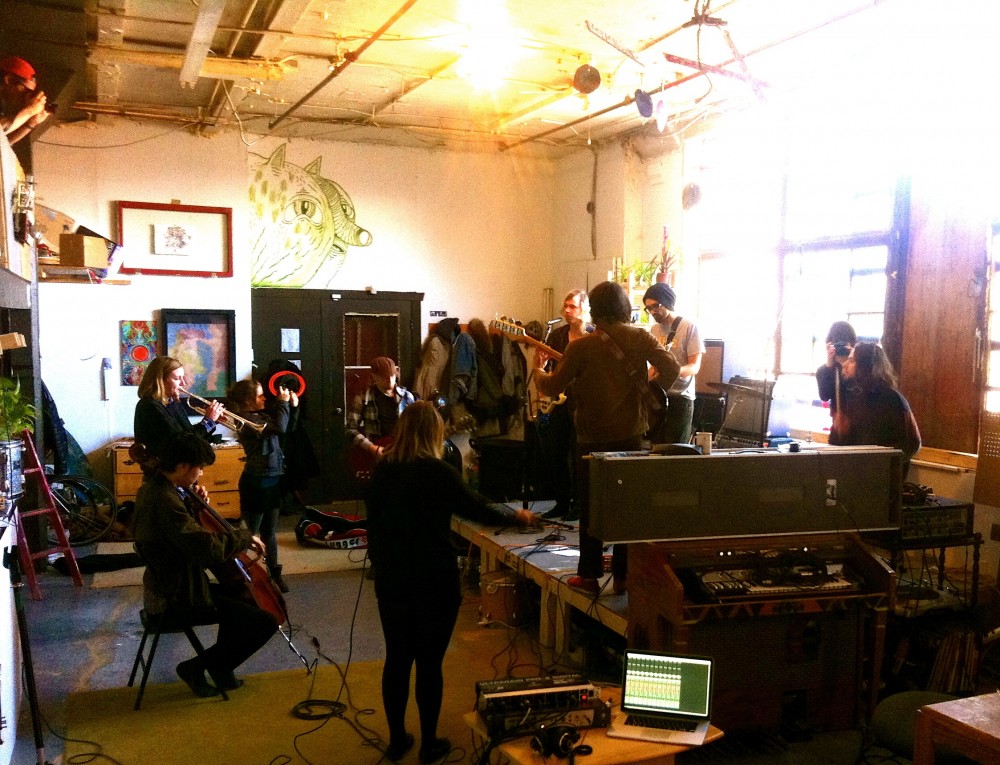
Archery Guild Attack!
Archery Guild are a local 8 or 9 piece baroque indie rock band. 3 Guitars, Trumpet, Cello, Violin, Bass, Drums and two vocalists make up the largest ensemble I’ve ever recorded in a multitrack, live-off-the-floor setting.
While setting up in the band’s beautiful St. Henri loft, it was obvious that the session would provide its fair share of challenges. Time was tight, and with so many instruments to capture, my XLR cables were at a premium. Luckily it didn’t take long to find the perfect spot to set up my rig, and after throwing mic after mic on stand after stand, we were ready for soundcheck.
Accompanied once again by the camera slingers of TVM, we successfully brought clarity to the chaos, and avoided more than a few potential pitfalls along the way.
The Two-Drum Deal
Archery Guild’s drummer (and fellow local recording engineer) Marshall Vaillancourt had minimized his usual kit, scrapping toms in favour of a simple Kick and Snare setup. He’d just finished mixing the band’s upcoming full length record (entitled “DIN” and available right over here) and was concerned about making sure the snare cut through the dense arrangement.
Instead of my standard 3 mic drum set up for these video sessions, we decided a mono single overhead setup would work best. I pointed one of my trusty C42’s directly over his shoulder, right at the centre of the snare, and told Marshall to bash away. At the end of the day, the only way to ensure a snare drum cuts through a dense mix is to hit it with everything you’ve got. Alongside a Beta 52 in the kick and an Apex 435 getting a birds eye view of the session from above the band, we got a solid and consistent drum sound we were both excited about.
Throw in a compressor and a wee bit of Massey’s Tape-Head saturation plugin (which I LOVE!), and the snare had no trouble staying front and centre.
Guitars Galore
I’ve worked with a whole slew of guitar based bands over the years, but 3 guitarists is still a relative rarity in my experience. Generally speaking, the more instruments you have fighting over the same sonic real estate, the more trouble you have maintaining balance and clarity when it comes time to mix.
Luckily, the trio of six string slingers knew a thing or two about sound themselves, and did an excellent job keeping out of each other’s auditory way. Three distinct tones, with three very different roles in the arrangement made it easy to keep all three instruments big and bold with out covering one another up. I did my best to support each guitarist’s tone with EQ, and then compressed them separately to give each one maximum punch. The panning was simple: one left, one right, and one dead centre.
Remember: there is stereo space, frequency space, dynamic space, and tonal space. The more of those each instrument has, the more room you’ve got to work with.
String Theory
Working with both a violinist and a cellist in a rock band setting was a bit of a tall order. Dealing with such resonant acoustic instruments can be tricky at typical rock and roll volumes, but both and I and band came prepared. Both of the string players had equipped their instruments with pickups, which made things simple when it came time to capture their sounds. I was a bit concerned during soundcheck that the pickups would produce a shrill, thin, generally undesirable sound on record, but during the mix it all came together.
Some gentle compression, a heaping tablespoon of EQ and a serious dash of reverb was all it took to get the strings sitting pretty. With such a dense arrangement, the relative “thin-ness” of the strings actually worked in my favour when balancing the midrange, keeping out of the way of the guitars but still providing lots of top end flourish.

It was a dense, complicated mix, but in the end it turned out clean, clear and punchy.
The Snare cut through, the strings came out strong and regal without muddying up the midrange, and each guitar came out sounding big and mean.
Luckily, the band did most of the work for me!
-D